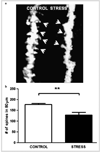Sex, stress, and mood disorders: at the intersection of adrenal and gonadal hormones
- PMID: 22581646
- PMCID: PMC3584173
- DOI: 10.1055/s-0032-1312592
Sex, stress, and mood disorders: at the intersection of adrenal and gonadal hormones
Abstract
The risk for neuropsychiatric illnesses has a strong sex bias, and for major depressive disorder (MDD), females show a more than 2-fold greater risk compared to males. Such mood disorders are commonly associated with a dysregulation of the hypothalamo-pituitary-adrenal (HPA) axis. Thus, sex differences in the incidence of MDD may be related with the levels of gonadal steroid hormone in adulthood or during early development as well as with the sex differences in HPA axis function. In rodents, organizational and activational effects of gonadal steroid hormones have been described for the regulation of HPA axis function and, if consistent with humans, this may underlie the increased risk of mood disorders in women. Other developmental factors, such as prenatal stress and prenatal overexposure to glucocorticoids can also impact behaviors and neuroendocrine responses to stress in adulthood and these effects are also reported to occur with sex differences. Similarly, in humans, the clinical benefits of antidepressants are associated with the normalization of the dysregulated HPA axis, and genetic polymorphisms have been found in some genes involved in controlling the stress response. This review examines some potential factors contributing to the sex difference in the risk of affective disorders with a focus on adrenal and gonadal hormones as potential modulators. Genetic and environmental factors that contribute to individual risk for affective disorders are also described. Ultimately, future treatment strategies for depression should consider all of these biological elements in their design.
© Georg Thieme Verlag KG Stuttgart · New York.
Figures



Similar articles
-
Hypothalamic-pituitary-adrenal and hypothalamic-pituitary-gonadal axes: sex differences in regulation of stress responsivity.Stress. 2017 Sep;20(5):476-494. doi: 10.1080/10253890.2017.1369523. Epub 2017 Aug 31. Stress. 2017. PMID: 28859530 Free PMC article. Review.
-
Sex differences in the hypothalamic-pituitary-adrenal axis' response to stress: an important role for gonadal hormones.Neuropsychopharmacology. 2019 Jan;44(1):45-58. doi: 10.1038/s41386-018-0167-9. Epub 2018 Aug 1. Neuropsychopharmacology. 2019. PMID: 30111811 Free PMC article. Review.
-
The stress system in the human brain in depression and neurodegeneration.Ageing Res Rev. 2005 May;4(2):141-94. doi: 10.1016/j.arr.2005.03.003. Ageing Res Rev. 2005. PMID: 15996533 Review.
-
Sex and stress steroids in adolescence: Gonadal regulation of the hypothalamic-pituitary-adrenal axis in the rat.Gen Comp Endocrinol. 2016 Aug 1;234:110-6. doi: 10.1016/j.ygcen.2016.02.004. Epub 2016 Feb 3. Gen Comp Endocrinol. 2016. PMID: 26851306 Review.
-
Sex, stress and steroids.Eur J Neurosci. 2020 Jul;52(1):2487-2515. doi: 10.1111/ejn.14615. Epub 2019 Dec 16. Eur J Neurosci. 2020. PMID: 31705553 Review.
Cited by
-
Sex and Gender Differences in Central Nervous System-Related Disorders.Neurosci J. 2016;2016:2827090. doi: 10.1155/2016/2827090. Epub 2016 May 30. Neurosci J. 2016. PMID: 27314003 Free PMC article. Review.
-
The World Federation of Societies of Biological Psychiatry guidelines on the assessment and pharmacological treatment of compulsive sexual behaviour disorder.Dialogues Clin Neurosci. 2022 Dec;24(1):10-69. doi: 10.1080/19585969.2022.2134739. Dialogues Clin Neurosci. 2022. PMID: 37522807 Free PMC article.
-
The impact of sex as a biological variable in the search for novel antidepressants.Front Neuroendocrinol. 2018 Jul;50:107-117. doi: 10.1016/j.yfrne.2018.05.003. Epub 2018 May 31. Front Neuroendocrinol. 2018. PMID: 29859882 Free PMC article. Review.
-
Beyond sex differences: new approaches for thinking about variation in brain structure and function.Philos Trans R Soc Lond B Biol Sci. 2016 Feb 19;371(1688):20150451. doi: 10.1098/rstb.2015.0451. Epub 2016 Feb 1. Philos Trans R Soc Lond B Biol Sci. 2016. PMID: 26833844 Free PMC article. Review.
-
MicroRNA Profiling and Bioinformatics Target Analysis in Dorsal Hippocampus of Chronically Stressed Rats: Relevance to Depression Pathophysiology.Front Mol Neurosci. 2018 Aug 6;11:251. doi: 10.3389/fnmol.2018.00251. eCollection 2018. Front Mol Neurosci. 2018. PMID: 30127715 Free PMC article.
References
-
- American Psychiatric Association. Diagnostic and statistical manual of mental disorders. 4th ed. Washington D.C: American Psychiatry Press Inc; 2000.
-
- Garcia-Alvarez R. Epidemiology of depression in Latin America. Psychopathlogy. 1986;19(Suppl 2):22–25. - PubMed
-
- Willner P, Mitchel PJ. The validity of animal models of predisposition to depression. Behav Pharmacol. 2002;13:169–188. - PubMed
-
- Recamier-Carballo S, Fernández-Guasti A. Forced swimming and chronic mild stress as animal models of depression. In: Cruz-Morales SE, Pedro Arriaga-Ramírez JC, editors. Behavioral animal models. Kerala, India: Research Signpost; 2012. pp. 123–137.
-
- de Kloet ER, Joels M, Holsboer F. Stress and the brain: from adaptation to disease. Nat Rev Neurosci. 2005;6:463–475. - PubMed

